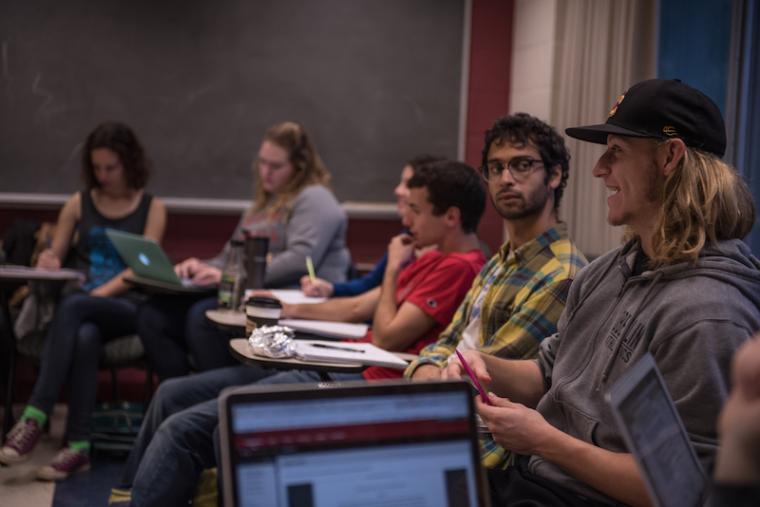Teaching the American Presidency in an Unprecedented Election
November 1, 2016
Amanda Nagy

Students in Jenny Garcia’s American Presidency course in fall 2016.
Photo credit: William Bradford
When an American politics course is offered during a general election cycle, students are eager to explore the finer points of the election in class. Assistant Professor Jenny Garcia’s American Presidency course is one such offering this semester where students—most of whom are voting in a presidential election for the first time—are trying to make sense of the polarization and political theater surrounding the presidential campaigns.
Garcia, new to the politics department this fall, came to Oberlin from Arizona State University. Her role in the department is focused on American politics and institutions. Her teaching and research also focuses on race and ethnic politics.
“In my American Presidency course, there are the mainstays that we cover, but I’ve spent more time discussing the election, teaching through the lens of whether this election is all that different from past elections, what it means to see the rise of either Hillary Clinton or Donald Trump, and whether those two candidates conform to our understanding of presidential candidates or are a surprise.”
Garcia says the class has read several pieces examining why people vote the way they do in elections, particularly in the presidency. “We talked about how one of the No. 1 predictors of understanding who is going to win a presidential election is how the economy is standing: if the economy is doing well, then the incumbent party seems to do well, and to what extent that is true for this election.”
Besides having a woman nominated by a major political party for the first time in history, this presidential election is unusual in ways that have surprised political scientists.
“Trump is using strategies that have never been used before in Republican campaigns. He’s relied quite a bit on racial strategies, and while this isn’t necessarily new, the way he’s doing it is new,” Garcia explains. “He’s invoking race in very explicit ways that have actually surprised political researchers because we have all this work that shows racial messaging does work and happens all the time, but it has to be covert and hidden for it to have the desired effect. Trump has been pretty explicit in the way he’s using race and ethnicity to build support. Political scientists are really trying to reconcile this with our previous understandings.”
Although both candidates have the lowest approval ratings of any presidential nominee in the last several decades, Garcia acknowledges that much of the conversation—both nationally and in class—has focused on Trump.
“One of the difficulties of studying the presidency in a classroom right now is that we’re so focused on Trump that Clinton gets pushed to the side a bit. But what’s really exciting about her is that we’re able to see how our research on female candidates, outside of the presidency, fits with her experience as the first female presidential candidate from a major political party. A lot of new research is looking at this election and the consequences of gender and Clinton’s campaign strategies; for instance, the words she uses when she talks, if they sound masculine or feminine; how Clinton has built up her credentials in international affairs and security—an area where female candidates have traditionally been described as weak—yet her experience allows her to counterbalance that.”
It just so happens that the GOP is giving Garcia’s class plenty to talk about. “The Republican Party has nominated someone that a good chunk of the party does not support, so we’re watching that divisiveness going forward. It will be interesting to see if the party realigns itself and gets back together, or if this is the beginning of a new party era.”
Getting back to the economy, though, Garcia says the angst and negativity surrounding both political parties makes sense from a political science point of view. “We have a whole bunch of frustrated Americans who haven’t been fully brought out of the recession. They feel like neither political party is listening to them, so they’re looking for something new.”
Garcia is currently working on a book that tracks the legislative strategies members of Congress have used to advance policy priorities for African Americans and marginalized constituencies from the 1950s to today.
“The Congress in the 1950s was clearly much different for African Americans than it is today. I’m tracking what this means for the ways black members of Congress go about trying to make law and influence policy, and what this means for representation for African Americans and other marginalized subgroups.”
Garcia says she’s thrilled to see how active and engaged Oberlin students are, both in and out of the classroom. “Coming to Oberlin has been exciting because the students have a real interest in what we’re doing and they’re quite active about it. I quickly realized that my students had already done the reading, so we didn’t have to go over basics and we could start analyzing the arguments. You can see such great potential in Oberlin students. I have one student who is applying for a job in Congress. They’re doing such exciting things and eager to get into research.”
You may also like…
Friday Afternoon with Lab Crawl
This year’s Lab Crawl drew what may be the largest crowd in the event’s illustrious history, with some 500 students and dozens of faculty taking part. Missed out on the excitement? It looked something like this.
Lab Crawl: It’s Not Just for Scientists
Oct. 27 open house highlights research across the sciences—and just about everywhere else.
In the Path of Disaster
Monica Dix travels to a hub of natural calamity to probe its risks and resilience.


